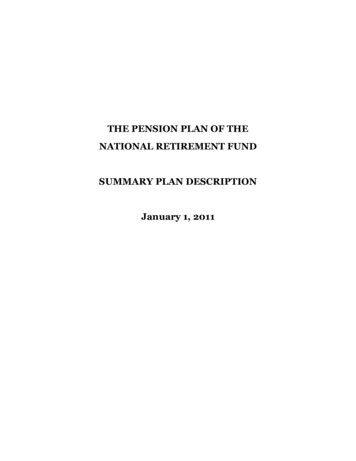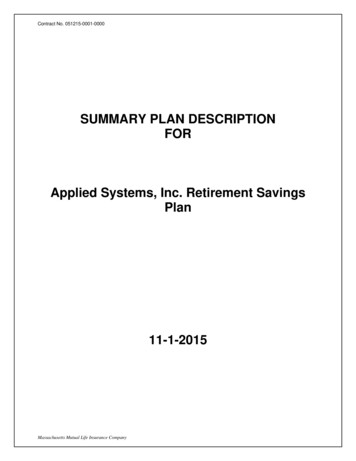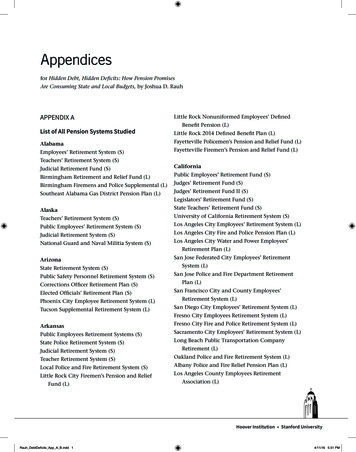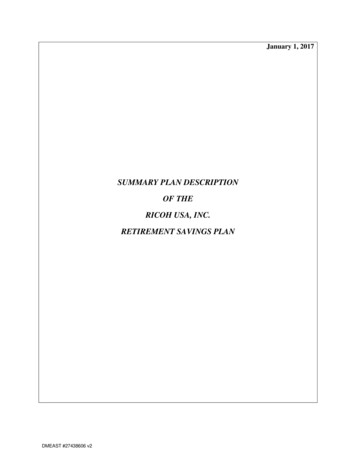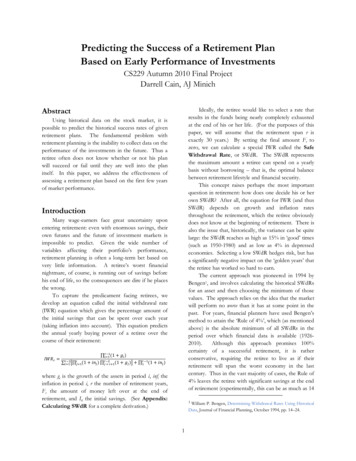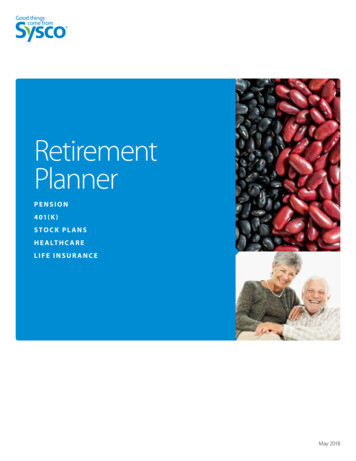
Transcription
Choosing Your Retirement Plan Optional Retirement Plan for Higher Education Plan 2 VRS Hybrid Retirement PlanMembership Date: On or after January 1, 2014A comparison guideto help you selectthe best planfor your needs
Choosing Your Retirement Plan Optional Retirement Plan for Higher Education Plan 2 VRS Hybrid Retirement PlanMembership Date: On or after January 1, 2014This comparison guide is designed to help employees of colleges and universities choose between theOptional Retirement Plan for Higher Education (ORPHE) Plan 2 and the Virginia Retirement System (VRS)Hybrid Retirement Plan.Table of ContentsPageIntroduction 3Choosing Your Retirement Plan 4Defined Contribution Plan: ORPHE Plan 2 4VRS Hybrid Retirement Plan 4Comparing Plans 6Compare and Select Plans in myVRS18Investment Options 19Your Selection 19Glossary of Terms 202 ORPHE.VARETIRE.ORG 888-827-3847Benefit Calculations and Illustrations21The information contained in this document is governed by Title 51.1 of the Code of Virginia. This information isintended to be general. It cannot be complete in all details and cannot supersede or restrict the authority granted by theCode of Virginia, which may be amended from time to time.05-2021
IntroductionAs a new Virginia college or university president, chancellor or faculty member engaged in teaching,administration or research, you are eligible to choose between the Optional Retirement Plan for HigherEducation (ORPHE) Plan 2, a defined contribution plan, and the Virginia Retirement System (VRS) HybridRetirement Plan. Your employer notifies VRS of your hire date and VRS sends you an eligibility letter withdirections on using your myVRS account to select a plan. If you do not select a plan within the 60-dayelection window based on your hire date, you will be covered by the VRS Hybrid Retirement Plan.If your membership date* is on or after January 1, 2014, and you are eligible for ORPHE, you have theoption to elect ORPHE Plan 2 or the Hybrid Retirement Plan. If you have prior service under VRS Plan 1or VRS Plan 2, you are not eligible to elect the Hybrid Retirement Plan and will select between VRS Plan 1or VRS Plan 2 (as applicable) or ORPHE, based on your hire date. Please refer to the comparison guides forVRS Plan 1/ORPHE Plan 1 and VRS Plan 2/ORPHE Plan 2 for more information.To see an estimate of your VRS member benefits, create a secure myVRS account at myvrs.varetire.org.Your myVRS account shows your total service credit, funds in your member contribution account and aprojected monthly retirement benefit based on your VRS service.If you move from one faculty position to another without a bona fide break in service, you must continuein the plan you originally chose. If you have a bona fide break in service, you have to choose between thetwo retirement plans again. A bona fide break in service is a break of at least one full calendar month fromthe last date of employment during a period the employee normally would work. Periods of leave withor without pay do not count toward satisfying this break in service. For faculty members, summer breaks,intersession periods, educational leave and sabbaticals also do not count toward satisfying this break.If you move from a position where you were covered under the VRS Hybrid Retirement Plan and arechoosing ORPHE, you may transfer the funds in your VRS member contribution account to your ORPHEaccount.If you move from one VRS-participating employer to another and elect the VRS Hybrid Retirement Plan inboth positions, your VRS service credit continues.If you move from a position where you were covered by the University of Virginia Medical Center optionalretirement plan, your participation in the UVA Medical Center plan will not count toward VRS servicecredit or ORP participation. The UVA Medical Center offers a separate ORP that is not authorized oradministered by VRS.If you move from a position where you elected ORPHE and become covered under the VRS HybridRetirement Plan, your ORPHE account remains in place, and you may not take a direct distribution orrollover until you leave covered employment.* Membership is based on the date you are first reported to VRS in a covered position. If you have previous VRS service buttook a refund, your membership date is the date you return to covered employment.** The College of William and Mary; George Mason University; the University of Virginia, including UVA at Wise andthe Southwest Virginia Higher Education Center; Virginia Commonwealth University; and Virginia Tech administerseparate ORP plans for their faculty members. These plans are authorized under VRS. For more information, see theOptional Retirement Plan for Higher Education Handbook for Participants available at orphe.varetire.org.3 CHOOSING YOUR RETIREMENT PLAN ORPHE & HYBRIDIf you move from a faculty position at an employer authorized by VRS to administer a separate ORP**from the VRS ORPHE without a bona fide break in service, you will have a 30-day window to select a newprovider. You will not have a new plan election as you must continue in the plan you originally chose.
Choosing Your Retirement PlanPreparing for retirement is about having enough income to live comfortably after you retire. Most financialplanning experts recommend 80% of your current earnings as a retirement income target. As a new Virginiacollege or university faculty member engaged in teaching, administration or research, you have the option tochoose between two retirement plans.Defined Contribution Plan: ORPHE Plan 2ORPHE is a defined contribution plan where vesting is immediate: the total balance in your account isavailable to you when you leave covered employment and are not re-employed by a VRS-participatingemployer offering retirement benefits under Title 51.1 of the Code of Virginia. For ORPHE Plan 2, yourbenefit is based on contributions from both you and your employer, adjusted for gains, losses and fees. Youchoose how the contributions will be invested from a range of options. You bear the investment risk, andthe amount of your benefit depends on the net investment earnings.For more information, see the Optional Retirement Plan for Higher Education Handbook for Participants available atorphe.varetire.org.VRS Hybrid Retirement PlanThe Hybrid Retirement Plan combines the features of a defined benefit plan and a defined contributionplan. The plan applies to most members hired on or after January 1, 2014. The defined benefit is based onyour age, service credit and average final compensation at retirement using a formula. The benefit from thedefined contribution plan depends on the contributions made to the plan and the investment performanceof those contributions. In addition to the monthly benefit payment payable from the defined benefit planat retirement, you may start receiving distributions from the balance in your defined contribution account,reflecting the contributions, investment gains or losses and any required fees.4 ORPHE.VARETIRE.ORG 888-827-3847Your retirement benefit is funded through mandatory and voluntary contributions made by you and youremployer to both the defined benefit and the defined contribution components of the plan. Mandatorycontributions are based on a percentage of your creditable compensation and are required from bothyou and your employer. Additionally, you may choose to make voluntary contributions of more than themandatory amount to the defined contribution component of the plan, and your employer is required tomatch those voluntary contributions according to specified percentages.Under the defined benefit component, vesting is the minimum length of service needed to qualify for aretirement benefit. Once you are vested, you are eligible for a retirement benefit if you meet the age andservice credit requirements for your plan. You become vested under the defined benefit component whenyou have at least five years (60 months) of service credit. For more details, please refer to the Vesting sectionin Comparing Plans.Under the defined contribution component, vesting is the minimum length of service members need to beeligible to withdraw employer contributions from that component of the plan. You are always 100% vestedin the contributions that you make. For more details, please refer to the Vesting section in Comparing Plans.
Normal retirement age under the VRS Hybrid Retirement Plan is your normal Social Security retirementage for the purpose of the defined benefit component. You become eligible for an unreduced retirementbenefit at your normal Social Security retirement age with at least five years (60 months) of service creditor when your age and service equal 90. You may retire with a reduced benefit as early as age 60 with at leastfive years (60 months) of service credit. To determine your reduced benefit, VRS applies an early retirementreduction factor to the benefit you would receive if you retired with an unreduced benefit. For the definedcontribution component, you are eligible to receive distributions upon leaving employment, subject torestrictions.For more information, see the Virginia Retirement System Hybrid Retirement Plan Handbook for Members availableat varetire.org/hybrid under Publications.Other Benefits to Consider When Choosing Your Plan5 CHOOSING YOUR RETIREMENT PLAN ORPHE & HYBRIDYour benefits will vary depending on the plan you select. A few key factors to consider: Employer contribution amounts. How long you plan to work for a VRS-participating employer. Portability. Your degree of control over your plan. Your comfort level with investment risk and bearing the responsibility for investing. The amount of your estimated defined benefit. Cost-of-Living Adjustment (COLA). Retirement eligibility age. Life insurance and disability offerings.
Comparing PlansThe following summary gives you a general comparison of the two plans based on stated assumptions:SubjectVRS Hybrid Retirement PlanORPHE Plan 2Type of PlanVRS Hybrid Retirement Plan combinesthe features of a defined benefit planand a defined contribution plan. The planapplies to most members hired on or afterJanuary 1, 2014, and to VRS Plan 1 andVRS Plan 2 members who opted into theplan during a special election window. The defined benefit is based on yourage, service credit and average finalcompensation at retirement using aformula. The benefit from the definedcontribution plan depends on thecontributions made to the plan andthe investment performance of thosecontributions. In addition to the monthly benefitpayable from the defined benefitplan at retirement, you may startreceiving distributions from thebalance in your defined contributionaccount, reflecting the contributions,investment gains or losses and anyrequired fees.ORPHE Plan 2 is a defined contributionplan. Your retirement benefit dependson the contributions provided to the planand the investment performance of thosecontributions. At retirement, a participantmay start receiving distributions from thebalance in his or her account, reflectingthe contributions, investment gains orlosses and any required fees.ContributionsYour retirement benefit is funded throughmandatory and voluntary contributionsmade by you and your employer to boththe defined benefit and the definedcontribution components of the plan.For ORPHE Plan 2, your benefit is basedon employer and employee contributionsand investment gains and losses on thosecontributions.Defined benefit:6 ORPHE.VARETIRE.ORG 888-827-3847By you: 4% of your creditablecompensation each month is mandatory.By your employer: total employercontribution rate less any employercontributions to your defined contributioncomponent.Defined contribution:By you: 1% of your creditablecompensation each pay period ismandatory, which your employermatches. And, you may choose voluntarycontributions up to 4% of your creditablecompensation, with partial match byemployer.By your employer: 8.5% of your creditablecompensation per pay date (someemployers: up to an additional 0.4%).By you: an additional 5% per pay date.State general fund money may not beused for this purpose.The contribution rate is set by statuteand is reviewed periodically by the VRSBoard of Trustees. Available investmentsare chosen by the VRS investment staffwith oversight by the Board of Trustees.You are responsible for selecting theinvestments from those available and youbear the investment risk.
Contribution LimitsVRS Hybrid Retirement PlanORPHE Plan 2Internal Revenue Code Section401(a)(17) states that compensationused to calculate your benefit may notexceed the compensation limit for theplan year in which the compensation wasearned. This is an annual limit, which maybe adjusted each year, depending on theamount of increase in the Consumer PriceIndex. See your benefits administrator forinformation on the current year’s limit.Internal Revenue Code Section 401(a)(17) specifies that the compensationon which you and your employer maymake contributions may not exceed thecompensation limit for the plan year inwhich the compensation is paid. See yourbenefits administrator for information onthe current year’s limit. The ORPHE planyear is from the second pay date in Julyof the current year to the first pay date inJuly the following year.Additionally, voluntary contributionsgo into the Hybrid 457 DeferredCompensation Plan. The IRS imposesan annual contribution limit on 457plans, which includes the Hybrid 457Deferred Compensation Plan and theCommonwealth of Virginia 457 DeferredCompensation Plan.VestingDefined Benefit: Vesting is the minimumlength of service you need to qualify for afuture retirement benefit. You are vestedunder the defined benefit componentof the Hybrid Retirement Plan when youreach five years (60 months) of servicecredit. VRS Plan 1 or VRS Plan 2 memberswith at least five years (60 months) ofservice credit who opted into the HybridRetirement Plan will stay vested in thedefined benefit component.Defined Contribution: Vesting is theminimum length of service membersneed to be eligible to withdrawemployer contributions from thedefined contribution component ofthe plan. You are always 100% vestedin the contributions that you make.Upon retirement or leaving coveredemployment, you are eligible to withdrawa percentage of employer contributions.Distribution is not required by law untilage 72. After two years, you are 50% vestedand may withdraw 50% of employercontributions. After three years, you are 75% vestedand may withdraw 75% of employercontributions. After four or more years, you are 100%vested and may withdraw 100% ofemployer contributions.See varetire.org, select DefinedContribution Plans and search ORPHE formore details.Vesting is immediate for your ORPHEaccount balance. You may take adistribution of all or a portion of yourORPHE account balance when you leaveemployment and qualify for a distribution.7 CHOOSING YOUR RETIREMENT PLAN ORPHE & HYBRIDSubject
SubjectLeaving EmploymentVRS Hybrid Retirement PlanDefined Benefit: If you leave coveredemployment and do not retire, youcan take a refund of your membercontributions and interest or leave yourmember contribution account balancewith VRS and become a deferred member.If you are vested before becoming adeferred member, you may be eligible fora future retirement benefit if you meetthe age and service requirements. If youare vested before taking a refund, youwill receive a full refund of your accountbalance. If you are not vested, you willreceive a refund of the balance, excludingany member contributions made byyour employer and the interest on thesecontributions. Taking a refund cancelsyour membership and eligibility for anyfuture VRS benefits.ORPHE Plan 2You may take a distribution from yourORPHE account when you are no longeremployed in a position that providesyou a retirement benefit through a planadministered or authorized by VRS. Youraccount balance may be left in the plan,where you continue to manage yourinvestments; rolled over; or taken as adistribution.See Taxation of Retirement Benefit foradditional information on this topic.Defined Contribution: There are a varietyof distribution options available toyou upon termination of employment,including partial or lump-sum payments,periodic payments or a combination ofboth. You also may choose to roll yourmoney to another employer’s plan or toan IRA.See Taxation of Retirement Benefit foradditional information on this topic.8 ORPHE.VARETIRE.ORG 888-827-3847PortabilityYes, if the employer is one of theapproximately 835 VRS-covered publicemployers, including all Virginia stategovernment agencies, all Virginia publiccolleges and universities, all Virginiapublic schools and most Virginia localgovernments.Service credit representing many types ofpublic service and leaves of absence maybe purchased to enhance the benefit.If you leave public employment inVirginia, your defined contributionaccount balance(s) may be rolled overto a subsequent employer’s qualifiedplan or an IRA. This is subject to vestingrules.Participation continues if you areemployed by another employer offeringORPHE.If you leave public employment in Virginia,your account balance may be rolled overto a subsequent employer’s qualified planor an IRA.
ConsolidatingRetirementSavings PlansVRS Hybrid Retirement PlanYou may be eligible to purchase servicefor other periods of public or militaryservice, including time covered by VRS,and refunded service. You may not rollmoney from other plans into VRS exceptto purchase approved service credit.Distributions from other retirement plansmay be rolled into the ORPHE separaterollover account. Funds rolled into ORPHEmay not be accessed until you terminateemployment and meet the break inservice requirements.You may roll payouts from otherretirement savings plans into the Hybrid457 Deferred Compensation Plan.Payouts from other retirementsavings plans can be rolled into theCommonwealth of Virginia 457 DeferredCompensation Plan, then the 401(a)Virginia Cash Match Plan, if youremployer has adopted both plans andyou participate in both plans. If yourolled funds from another retirement planinto your 457 Deferred CompensationAccount and/or Cash Match Account, youmay withdraw those funds while you arestill employed. Withdrawals made priorto age 59½ may be subject to a 10%penalty, plus state and federal income taxwithholding.Payouts from other retirementsavings plans can be rolled into theCommonwealth of Virginia 457 DeferredCompensation Plan, then the 401(a)Virginia Cash Match Plan, if youremployer has adopted both plans andyou participate in both plans. If you rolledfunds from another retirement plan intoyour 457 Deferred Compensation Accountand/or Cash Match Account, you maywithdraw those funds while you arestill employed. Withdrawals made priorto age 59½ may be subject to a 10%penalty, plus state and federal income taxwithholding.Investment RisksDefined Benefit: Your contributions areinvested by the Virginia RetirementSystem and your benefit is calculatedusing a formula.Defined Contribution: You choose howthe contributions will be invested from arange of options. You bear the investmentrisk, and the amount of your benefitdepends on the amount you contributeand net investment earnings.Investment CostsORPHE Plan 2Defined Benefit: Investment managementcosts are paid by earnings oncontributions to VRS.Defined Contribution: Investmentmanagement and record-keeping costsare paid by the employee.You choose how the contributions will beinvested from a range of options. You bearthe investment risk, and the amount ofyour benefit depends on the amount youcontribute and net investment earnings.Investment management and recordkeeping costs are paid by the employee.9 CHOOSING YOUR RETIREMENT PLAN ORPHE & HYBRIDSubject
SubjectCost-of-LivingAdjustment(COLA)VRS Hybrid Retirement PlanDefined Benefit: The cost-of-livingadjustment (COLA) matches the first 2%increase in the Consumer Price Index forall Urban Consumers (CPI-U) and half ofany additional increase (up to 2%), fora maximum COLA of 3% for the definedbenefit component.ORPHE Plan 2Cost-of-living adjustments are notavailable with this feature unless youpurchase an annuity.Defined Contribution: The COLA is notapplicable to the defined s PlansEmployers may offer additionalsavings opportunities, including theCommonwealth of Virginia 457 DeferredCompensation Plan and 401(a) VirginiaCash Match Plan, a 403(b) plan oranother supplemental savings plan.Employers may offer additionalsavings opportunities, including theCommonwealth of Virginia 457 DeferredCompensation Plan and 401(a) VirginiaCash Match Plan, a 403(b) plan oranother supplemental savings plan.Taxation of RetirementBenefitDefined Benefit: No tax is due until youbegin receiving your retirement benefit.Your retirement benefit is subject tofederal income taxes as well as stateincome taxes if you live in a state thattaxes income. No early retirement excisetax is due on a lifetime benefit.No tax is due until you take a distributionfrom the plan. The amount distributeddirectly to you is subject to federal incometaxes as well as state income taxes ifyou live in a state that taxes income.Distributions from ORPHE also may incuran early distribution excise tax if takenprior to age 59½. An exception applies ifyou separate from service after age 55,receive an annuity or take essentiallyequal payments during your lifetime.Taxation may be postponed if you roll overthe distribution to another employer’splan or to an IRA.10 ORPHE.VARETIRE.ORG 888-827-3847Defined Contribution: No tax is due untilyou take a distribution from the plan.The amount distributed directly to you issubject to federal income taxes as wellas state income taxes if you live in a statethat taxes income. Distributions fromthe Hybrid 401(a) Cash Match Plan alsomay incur an early distribution excise taxif taken prior to age 59½. An exceptionapplies if you separate from serviceafter age 55, receive an annuity or takeessentially equal payments during yourlifetime. Taxation may be postponed ifyou roll over the distribution to anotheremployer’s plan or to an IRA.Educational Leaveof AbsenceWith Half Pay or MoreYou will be reported to VRS at the full rateof pay.Employee and employer contributions willcontinue to be paid on the salary earnedwhile on educational leave.Educational Leaveof AbsenceWith Less Than HalfPayNo employee or employer contributionsare paid. You may purchase up to fouryears of service credit for any approvedofficial educational leave of absence froma VRS-covered position when you return toemployment.No contributions are made to ORPHE. Nomake-up contributions are made whenyou return to employment.
DisabilityVRS Hybrid Retirement PlanHybrid Retirement Plan members who arestate employees are covered under theVirginia Sickness and Disability Program(VSDP) and are not eligible for disabilityretirement.Your employer also may provide a shortand/or long-term disability plan.ORPHE Plan 2Institutions may provide disabilitycoverage or make it available forpurchase. Contact your human resourceoffice for information on programs thatmay be available to you. You also maybe eligible to apply for Social Securitydisability.When employment ends as a result of adisability, a distribution from ORPHE maybegin.Order of PrecedenceYou may choose the order established bylaw to provide payment of your benefits oryou may designate specific beneficiariesto receive your benefits in the event ofyour death. The order of precedence is asfollows: First, to the spouse of the member; Second, if no surviving spouse, tothe children of the member anddescendants of deceased children, perstirpes; Third, if none of the above, to theparents of the member; Fourth, if none of the above, to the dulyappointed executor or administrator ofthe estate of the member; Fifth, if none of the above, to other nextof kin of the member entitled under thelaws of the domicile of the member atthe time of his death.You may choose the order established bylaw to provide payment of your benefits oryou may designate specific beneficiariesto receive your benefits in the event ofyour death. The order of precedence is asfollows: First, to the spouse of the member; Second, if no surviving spouse, tothe children of the member anddescendants of deceased children, perstirpes; Third, if none of the above, to theparents of the member; Fourth, if none of the above, to the dulyappointed executor or administrator ofthe estate of the member; Fifth, if none of the above, to other nextof kin of the member entitled under thelaws of the domicile of the member atthe time of his death.Death-in-Service:Non-Work-RelatedDefined Benefit: A death-in-service benefitis a lump-sum payment of the balance inyour member contribution account, if any,to your named beneficiary. If your namedbeneficiary is your spouse, your natural orlegally adopted minor child or your parent,he or she may elect a lump-sum paymentor a monthly benefit. The death-in-servicebenefit is in addition to any life insurancebenefits you may have.Defined Contribution: The definedcontribution account balance is payableto your named beneficiary. If you have notnamed a beneficiary, the balance is paidaccording to the order of precedence. Thebeneficiary may choose from a variety ofpayment methods.The ORPHE account balance is payableto your named beneficiary. If you have notnamed a beneficiary, the balance is paidaccording to the order of precedence. Thebeneficiary may choose from a variety ofpayment methods.11 CHOOSING YOUR RETIREMENT PLAN ORPHE & HYBRIDSubject
SubjectDeath-in-Service:Work-RelatedVRS Hybrid Retirement PlanORPHE Plan 2Defined Benefit: If you die while you arean active member from a work-relatedcause, your named beneficiary will beeligible for a lump-sum payment ofany funds remaining in your membercontribution account. In addition, yourspouse, natural or legally adopted minorchild or parent will be eligible for amonthly benefit. If this individual also isyour named beneficiary, he or she willreceive both benefits. If your beneficiaryis eligible for Social Security survivorbenefits, the VRS work-related benefit willbe equal to 331/3% of your average finalcompensation (AFC) at the time of yourdeath. If he or she is not eligible, the VRSbenefit will be equal to 50% of your AFC.If your beneficiary is eligible for a workers’compensation survivor benefit, the VRSwork-related benefit is offset by theworkers’ compensation benefit.The ORPHE account balance is payableto your named beneficiary. If you have notnamed a beneficiary, the balance is paidaccording to the order of precedence. Thebeneficiary may choose from a variety ofpayment methods.No work-related, death-in-service benefitis available.Defined Contribution: The accountbalance is payable to your namedbeneficiary. If you have not nameda beneficiary, the balance is paidaccording to the order of precedence. Thebeneficiary may choose from a varietyof payment methods. No work-related,death-in-service benefit is available.12 ORPHE.VARETIRE.ORG 888-827-3847Health InsuranceCredit:Service RetirementYes, if you retire, are at least 50 yearsold and have at least 15 years of VRSdefined benefit service credit or ORPparticipation (or a combination of both).Deferred participants with 15 years ofVRS defined benefit service credit and/or ORP participation are eligible for thecredit when they turn 50 years old.Yes, if you retire, are 60 years old andhave at least 15 years of VRS definedbenefit service credit or ORP participation(or a combination of both). Deferredparticipants with 15 years of VRS definedbenefit service credit and/or ORPparticipation are eligible for the creditwhen they turn 60 years old.If you qualify, you will begin receivingyour health insurance credit when youbegin receiving your retirement benefitand incur a cost for your own healthinsurance. The monthly benefit is 4 peryear of service not to exceed the out-ofpocket cost for your individual premium.The credit ceases at your death.To qualify, you must incur a cost foryour own health insurance. The monthlybenefit is 4 per year of service not toexceed the out-of-pocket cost for yourindividual premium. The credit ceases atyour death.
Health InsuranceCredit:Educational LeaveVRS Hybrid Retirement PlanORPHE Plan 2Educational leave with less than half paydoes not count toward service credit forthe health insurance credit.Educational leave with less than half paydoes not count toward service credit forthe health insurance credit.Educational leave with half pay or morecounts as service credit for the healthinsurance credit.Educational leave with half pay or morecounts as service credit for the healthinsurance credit.Forfeiture of BenefitsYour VRS-administered benefits may beforfeited if you are convicted of a felonyrelated to your covered employment.Your VRS-administered benefits may beforfeited if you are convicted of a felonyrelated to your covered employment.Eligibility forBenefit PayoutDefined Benefit: Normal Social Securityretirement age, or when age and serviceequal 90.You may begin receiving benefits whenyou leave public employment in Virginia,regardless of age. The amount of thebenefit is determined by contributions toyour ORPHE account (including money yourolled into the plan), adjusted for gains,losses and fees on investments and thelength of time the benefit will be paid.Defined Contribution: When you leaveemployment, subject to restrictions.Benefit Payout OptionsDefined Benefit: When you retire, yourbenefit is paid first from your membercontribution account. After these fundshave been paid out, your benefit isfunded from a separate contribution youremployer makes to VRS and investmentearnings. You receive your retirementbenefit in the form of a monthly benefitaccording to a payout option y
As a new Virginia college or university president, chancellor or faculty member engaged in teaching, administration or research, you are eligible to choose between the Optional Retirement Plan for Higher Education (ORPHE) Plan 2, a defined contribution plan, and the Virginia Retirement System (VRS) Hybrid Retirement Plan.
